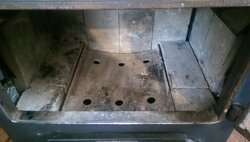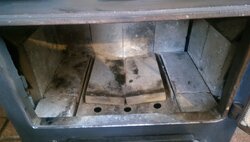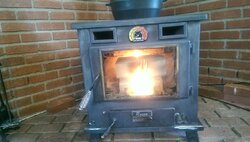Ok. Quick background. Bought the house in July. It came with a 1980 Russo coal and wood stove. Definitely not epa and due to the placement of the air intake I get a rather mediocre wood stove. Although surprisingly it's not terrible.
Anyway. It has firebrick sides and a metal grate on the bottom with holes in it. Manual says you can burn right on the grate for wood. I know that Russo sells specially shaped brick for the floor edges. It's over 100 bucks. Pass.
I ran it for a few months with just the bottom and no brick on the floor. I haven't had any problems besides getting about 3 to 4 hours per load. One day I decided to add some brick. I put it on the sides of the floor. End result it that it took a bit more time to come to temp and it burned a little hotter.
Few days later i put in 2 more bricks on the grate which leaves a space for the front air holes but not the back ones. Benefit is a much more flat stove floor because the metal grate has a slight bow. Easier to fill with wood. I assumed and was correct that the back of the box wouldn't burn as well due to the covered holes. Now it didn't burn badly, remedy is to just rake everything forward a bit after a few hours.
At this point the stove easily takes 20 more minutes to come to temp but it burns hotter and holds temperature twice as long as it originally did. I even had hot coals when I got up for work. Granted that's 330 but originally the stove was room temperature at that hour with no floor brick. Not even a hint of heat. The one caveat is due to the higher temps I go thru a load a little faster.
So my question is if it's possible to add some air intakes in the sides or one side and get a better slower burn? Basically line the floor with brick and close the air that's below the brick and grate. I can weld and have access to the tools to do the job. I'm not gonna go crazy beyond that because although this is in my den/converted garage there will probably be an ideal steel hybrid in the living room in the future. I'll probably keep this stove in th e den since its apparently an add on to the hvac system and it gets chilly in there.
Here's a few pics.

Grate with side bricks above

Bricks on grate above
Anyway. It has firebrick sides and a metal grate on the bottom with holes in it. Manual says you can burn right on the grate for wood. I know that Russo sells specially shaped brick for the floor edges. It's over 100 bucks. Pass.
I ran it for a few months with just the bottom and no brick on the floor. I haven't had any problems besides getting about 3 to 4 hours per load. One day I decided to add some brick. I put it on the sides of the floor. End result it that it took a bit more time to come to temp and it burned a little hotter.
Few days later i put in 2 more bricks on the grate which leaves a space for the front air holes but not the back ones. Benefit is a much more flat stove floor because the metal grate has a slight bow. Easier to fill with wood. I assumed and was correct that the back of the box wouldn't burn as well due to the covered holes. Now it didn't burn badly, remedy is to just rake everything forward a bit after a few hours.
At this point the stove easily takes 20 more minutes to come to temp but it burns hotter and holds temperature twice as long as it originally did. I even had hot coals when I got up for work. Granted that's 330 but originally the stove was room temperature at that hour with no floor brick. Not even a hint of heat. The one caveat is due to the higher temps I go thru a load a little faster.
So my question is if it's possible to add some air intakes in the sides or one side and get a better slower burn? Basically line the floor with brick and close the air that's below the brick and grate. I can weld and have access to the tools to do the job. I'm not gonna go crazy beyond that because although this is in my den/converted garage there will probably be an ideal steel hybrid in the living room in the future. I'll probably keep this stove in th e den since its apparently an add on to the hvac system and it gets chilly in there.
Here's a few pics.

Grate with side bricks above

Bricks on grate above
Last edited by a moderator:


